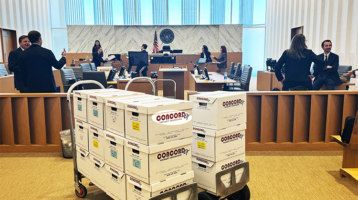From social media and texting to government investigations, these are the biggest e-discovery cases from this past year.

Listing the top five e-discovery cases in 2015 can be premature. Cases are often not valuable until the precedents are used to support facts in other cases. These cases are prefaced with important e-discovery topics that persist year over year with different cases and characters.
1. Costs: Colosi v. Jones
Prevailing parties can recover a portion of their electronic discovery costs at the conclusion of litigation under the cost statute, 28 U.S.C. § 1920(4), which permits taxing fees for exemplification and making copies of materials obtained for the case. But the moving party must show the costs were necessary to make copies, such as the conversion of electronic documents to TIFF.
E-discovery costs are generally not taxable, such as costs for document collection, processing, and hosting. But in Colosi v Jones Lang LaSalle Americas, Inc., 781 F.3d 293, 297 (6th Cir. 2015), Judge Keith Cook found that “imaging a hard drive falls squarely within the definition of “copy,” albeit the definition remains rooted in its historical context and does not include the costs for de-duplicating and culling data to meet discovery requirements.
The cost statute includes no categorical bar to taxing e-discovery costs. It authorizes courts to tax “the costs of making copies of any materials where the copies are necessarily obtained for use in the case.” Cook asked whether imaging a hard drive, or other physical storage device, falls within the ordinary meaning of “making copies.”
Turning to the Oxford English Dictionary, Cook defined “copy” as a “transcript or reproduction of an original” and then transformed copy into “image.” An image serves as a functional reproduction of the physical storage disk where you can access any application file or electronic document on the hard drive with all that document’s original properties and metadata intact.
Cook did not ask whether imaging is the “functional equivalent” of making photocopies before ‘e’ prefaced discovery because—consistent with the Federal Rules of Civil Procedure 2008 amendments—the procedure comes within the ordinary meaning of “making copies of any materials.”
2. Technology-Assisted Review: Rio Tinto
Technology-assisted review (TAR), wrote Magistrate Judge Andrew Peck of the U.S. District Court for the Southern District of New York, “Is now black letter law that where the producing party wants to utilize TAR for document review, courts will permit it.” Rio Tinto PLC v Sale S.A., 306 F.R.D 125 (S.D.N.Y. March 2, 2015).
In Rio Tinto when a mining company and its competitor faced off in a conspiracy action, the litigants submitted a proposed agreement for discovery with a TAR, i.e. predictive coding, protocol. Magistrate Judge Peck approved the agreement, leaving it to the parties to decide how best to respond to discovery requests. But one issue remained open: How transparent and cooperative the parties need be regarding TAR or predictive coding?
If parties don’t agree to transparency and cooperation regarding seed set used to train a predictive coding algorithm, courts are split on requiring transparency and giving an opponent full access to a set’s responsive and nonresponsive documents sans privileged documents. Transparency translates to disclosure—a pariah for litigation teams.
Peck attempted to cast out the pariah in Rio Tinto and decouple predictive coding from disclosures. Peck described several alternatives for TAR protocols that make disclosure unnecessary. If the TAR methodology uses continuous active learning, “the contents of the seed set is much less significant,” said Peck. Statistical estimation of recall post review can identify gaps in production and provide quality control review of non-responsive document samples.
3. Government Investigations: U.S. v. Davis
Courts were not quick to relinquish the government’s ability to apprehend criminals and prevent them from committing future offenses in 2015. The Stored Communications Act (SCA) provides that a federal or state governmental entity may require a telephone service provider to disclose business records pertaining to a subscriber or customer, not including the contents of communications, if a court finds specific and articulable facts showing reasonable grounds to believe that the records sought are relevant and material to an ongoing criminal investigation. 18 U.S.C. secs. 2701, 2703 et seq.
Under the SCA, some circuit courts do not require the government to obtain a warrant and show probable cause to obtain records applicable to the SCA. U.S. v Davis, 785 F.3d 498, 502 (11th Cir. 2015) cert. denied, 84 USLW 3081 (U.S. Nov. 9, 2015). In Davis, appellant Quartavious Davis lodged a constitutional challenge to a court order issued without a warrant but under the SCA to compel the production of a third-party telephone company’s business records containing historical cell tower location information. Judge Hull responded, “The Fourth Amendment prohibits unreasonable searches, not warrantless searches.” U.S. v. Davis, at 516.
Hull found Davis had a diminished expectation of privacy in business records made, kept, and owned by a telephone service provider; the production of those records did not amount to a serious invasion of a privacy interest, particularly because of the privacy protections built into the SCA; disclosing telephone business records under a court order authorized by Congress served substantial governmental interests.
4. Text Messaging: Clear-View Technologies v. Rasnick
The duty to preserve documents and electronically stored information relevant to litigation can be triggered long before a lawsuit is filed. In most circuits, the duty is triggered when litigation is reasonably foreseeable; in others, when a potential litigant knew or should have known litigation was imminent.
Text messaging is not considered a business application, and texts are usually not retained as business records. But the world of social media is quickly changing the face of business and litigation. Magistrate Judge Paul Grewal of the U.S. District Court for the Northern District of California found in Clear-View Technologies, Inc. v Rasnick that defendants had an obligation to preserve evidence after plaintiff sent them text messages threatening a lawsuit two years prior to its filing. Clear-View Techs., Inc. v Rasnick, 5:13-cv-02744-BLF, 2015 WL 2251005 (N.D. Cal. May 13, 2015).
After receiving the text messages, defendants discarded personal computers and handheld devices without regard to preserving evidence, intentionally deleted relevant documents, and failed to implement a hold or monitoring policy. During the litigation, defendants ran proprietary software to wipe files from a hard drive while plaintiff’s motion to compel discovery was pending.
Grewal clarified that the court issues sanctions under the Federal Rules of Procedure, Rule 37, when a discovery order is violated, absent substantial justification or injustice. He added that if Rule 37 did not apply, the court has additional discretion under its inherent authority to respond to abusive litigation practices. The official comments to Rule 37, effective December 1, acknowledge the FRCP limits in addressing the exponential growth of electronically stored information and the different standards crafted by federal courts for imposing curative ‘measures’ and sanctions on parties who fail to preserve ESI.
5. Social Media: Silva v. Dick’s Sporting Goods
Although social media content is stored as an electronic file not file cabinet, the e-file gives no moving party the right to discover its entirety without more. Silva v Dick’s Sporting Goods, Inc., 3:14-cv-580 (WWE)(WIG), 2015 WL 1275840 (D. Conn. Mar. 19, 2015).
In Silva, Magistrate Judge Garfinkel refused defendant Dick’s Sporting Goods motion to compel plaintiff Eric Silva to reproduce non-redacted copies of 2,254 pages of Facebook messages. The defendant’s original discovery request asked for a copy of the contents of plaintiff’s Facebook wall posts and private messages if the communications related to defendant, plaintiff’s employment with defendant, and plaintiff’s emotional feelings or mental health, and/or allegations in the complaint.
Defendant’s request for a non-redacted copy of all of Plaintiff’s Facebook communications was too broad. There are approximately 2,254 pages of messages connected with Plaintiff’s account. The court credited plaintiff’s assurances that not all messages related to the litigation. Postings not germane to the issues are not relevant and the court will not compel them to be produced.
Under the revised discovery scope, Rule 26(b)(1) effective Dec. 1, it may become even harder for litigants to get unfettered access to social network content. Although parties may still obtain discovery regarding any non-privileged matter relevant to a party’s claim or defense, the discovery must be proportional to the needs of the case, “considering the importance of the issues at stake in the action, the amount in controversy, the parties’ relative access to relevant information, the parties’ resources, the importance of the discovery in resolving the issues, and whether the burden and expense of the proposed discovery outweighs the likely benefit.”
The Committee Notes to the new Rule 26(b)(1) indicate the primary goal is to restore proportionality factors into discovery, albeit courts read proportionality into the old rule from Rule 26(b)(2)(C). The renewed emphasis on proportionality may place the burden of proof on parties moving to compel discovery to show that the discovery request is not only relevant but also proportional.
The 5 Biggest E-Discovery Cases of 2015



